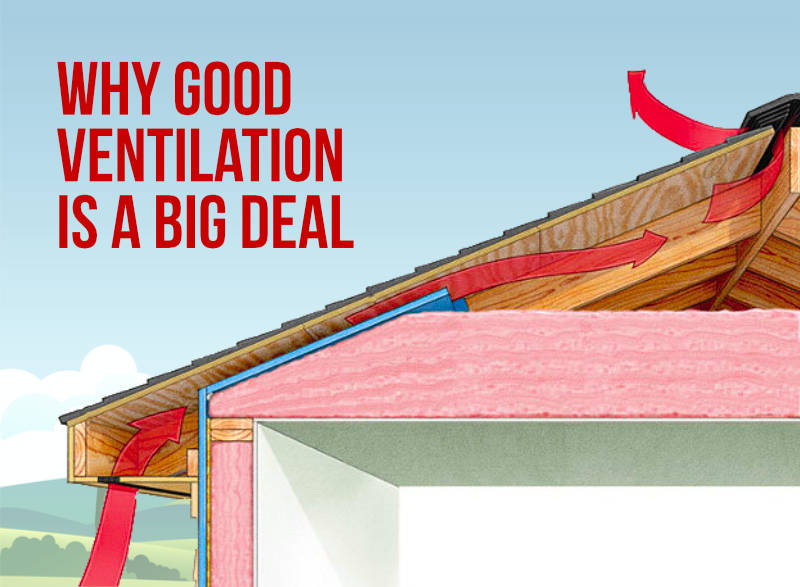December 18, 2019

When you re-roof your home, it is the perfect time to make sure that your home’s attic ventilation is functioning properly. That’s why we start every roof inspection with an attic inspection.
Why Good Ventilation is a Big Deal
Prevents mold and rot. Recent years have brought building science technologies that are making homes tighter and tighter. All of the moisture that is naturally created inside of our homes by cooking, laundry, houseplants, and bathing that used to migrate toward the drier outdoors through loose windows and doors and other ways is now trapped inside of our homes.
Unless your home has a great vapor barrier behind the walls and ceilings, that moisture then ends up in the attic. If it is not properly vented out of the attic, it condenses on cold surfaces in your attic, such as the underside of the roof when nighttime temperatures drop. Condensation in an attic will eventually lead to mold and even rot – not good things!
Here’s a 3-minute video by our own roofing expert Todd Miller on the subject of metal roofing and condensation.
Prevents high home operating and energy costs. Another chief reason for good attic ventilation is to help reduce your home’s summer heat gain. Your home’s roof is a giant solar collector. Once that heat enters your attic, if it is not directed back outside by proper ventilation, it ends up increasing your home’s cooling loads and operating costs.
Want to have more solar collection from your roof? Our metal roofing products are the perfect base for installing solar panels now or in the future. Learn more about how our long-lasting roofing products easily accommodate your future energy needs.
How Good Ventilation Works
Proper attic ventilation requires intake vents for fresh air and exhaust vents. Ventilation takes advantage of convective airflow (warm air rises) to keep bathing your attic with fresh air, pushing out the warm, moist air. Intake vents are usually located in the eave overhangs (soffits) of your home, while exhaust vents are usually at or near the ridge (peak) of your roof.
Most building codes require one square foot of vent area for every 300 square feet of attic floor space. The vent spaces should be balanced 50-50 between intake and exhaust vents. If anything, you want to have slightly more intake than exhaust vents. Having more exhaust vents than intake vents can cause the exhaust vents to act as intake vents, drawing weather in from the roof surface.
When you re-roof your home, an analysis should be done on the ventilation. It is also the right time to make sure that your intake vents have not gotten blocked by insulation or debris over the years.
Find the Right Roofing Contractor
Many people, including contractors, mistakenly believe that the heat-reflective finishes on today’s metal roofs reduce the need for attic ventilation. That is not true. Ventilation should still be done per code. Inadequate or reduced ventilation, unless the home has been specially constructed not to require ventilation, will lead to higher energy costs, ice dams, and a huge risk of attic condensation and mold. Regardless of what type of roof your home has, ventilation is very important.
We are experts in roof ventilation, and always take this important factor into our recommendations for your new roof.
Re-roof Anytime? Yes, We Can.
Remember, it’s always a roofing season in Georgia. At Lifetime Metal Roofing, we are available to help you figure out your roofing and ventilation needs, and help you find the right roof for your Atlanta area home. Give us a call or contact us anytime with your questions; we will be happy to guide you to a successful resolution.

 Todd Miller is President of Isaiah Industries, an organization that is recognized as one of the world’s leading metal roofing manufacturers, and manufacturer of Classic Metal Roofing Systems.
Todd Miller is President of Isaiah Industries, an organization that is recognized as one of the world’s leading metal roofing manufacturers, and manufacturer of Classic Metal Roofing Systems.